文章目录
104. 二叉树的最大深度
给定一个二叉树,找出其最大深度。
二叉树的深度为根节点到最远叶子节点的最长路径上的节点数。
说明: 叶子节点是指没有子节点的节点。
示例:
给定二叉树 [3,9,20,null,null,15,7],
3
/ \
9 20
/ \
15 7
返回它的最大深度 3 。
层序遍历思路
就是层序遍历
public int maxDepth(TreeNode root) {
Deque<TreeNode> que = new ArrayDeque<>();
if (root != null) {
que.offer(root);
}
int size; // 记录每层大小
int depth = 0; // 记录深度
while (!que.isEmpty()) {
size = que.size();
depth++;
while (size-- > 0) {
TreeNode node = que.poll();
// 每出队一个节点,就要让他的左右子树入队
if (node.left != null) {
que.offer(node.left);
}
if (node.right != null) {
que.offer(node.right);
}
}
}
return depth;
}
递归思路
首先要搞清楚什么是深度,什么是高度
- 二叉树节点的深度:指从根节点到该节点的最长简单路径边的条数或者节点数(取决于深度从0开始还是从1开始)
- 二叉树节点的高度:指从该节点到叶子节点的最长简单路径边的条数后者节点数(取决于高度从0开始还是从1开始)
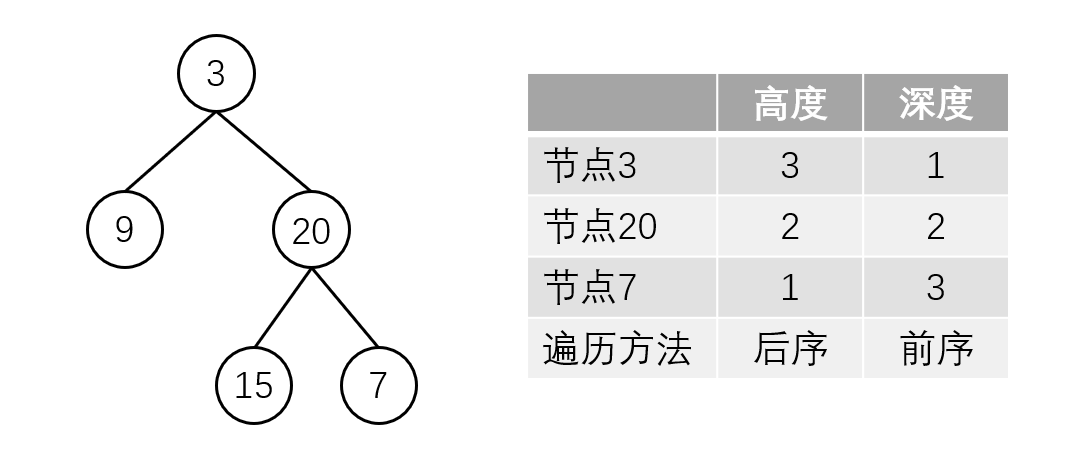
而根节点的高度就是二叉树的最大深度,所以本题中我们通过后序求的根节点高度来求的二叉树最大深度。
难点
-
为什么要用后序
因为最后要用的是根节点的高度来表示最大深度,求高度就要从下往上求,而后序遍历中,最后处理的是中,可以把叶子节点的信息返回给父节点,父节点知道了孩子节点的高度再+1
-
递归三要素
- 确定递归函数的参数和返回值:参数就是传入树的根节点,返回就返回这棵树的深度,所以返回值为int类型。
public int maxDepth1(TreeNode root)
- 确定终止条件:最后遍历到叶子节点的左右节点会是null,如果为空节点的话,就返回0,表示高度为0。
if (node == NULL) return 0;
- 确定单层递归的逻辑:先求它的左子树的深度,再求的右子树的深度,最后取左右深度最大的数值 再+1 (加1是因为算上当前中间节点)就是目前节点为根节点的树的深度。
// 后序遍历:左右中
int leftDepth = maxDepth1(root.left); // 左
int rightDepth = maxDepth1(root.right); // 右
return Math.max(leftDepth, rightDepth) + 1; // 中
完整代码:
// 递归-----------------------------------------------------------
public int maxDepth1(TreeNode root) {
if (root == null) {
return 0;
}
// 后序遍历:左右中
int leftDepth = maxDepth1(root.left); // 左
int rightDepth = maxDepth1(root.right); // 右
return Math.max(leftDepth, rightDepth) + 1; // 中
}
// 递归-----------------------------------------------------------
559. N 叉树的最大深度
给定一个 N 叉树,找到其最大深度。
最大深度是指从根节点到最远叶子节点的最长路径上的节点总数。
N 叉树输入按层序遍历序列化表示,每组子节点由空值分隔(请参见示例)。
示例1:
输入:root = [1,null,3,2,4,null,5,6]
输出:3
示例2:
输入:root = [1,null,2,3,4,5,null,null,6,7,null,8,null,9,10,null,null,11,null,12,null,13,null,null,14]
输出:5
思路
和二叉树求最大深度一样用后序
// 递归-----------------------------------------------------------
public int maxDepth(Node root) {
if (root == null) {
return 0;
}
int depth = 0;
for (Node child : root.children) {
int childDepth = maxDepth(child);
depth = Math.max(depth, childDepth);
}
return depth + 1;
}
// 递归-----------------------------------------------------------
111. 二叉树的最小深度
给定一个二叉树,找出其最小深度。
最小深度是从根节点到最近叶子节点的最短路径上的节点数量。
**说明:**叶子节点是指没有子节点的节点。
层序遍历思路
层序遍历,只有当左右孩子都为空的时候,才说明遍历的最低点了。如果其中一个孩子为空则不是最低点
如果当前节点的左右孩子都为空,直接返回最小深度
if (node.left == null && node.right == null){
return depth;
}
完整代码
public int minDepth(TreeNode root) {
Deque<TreeNode> que = new ArrayDeque<>();
if (root != null) {
que.offer(root);
}
int size; // 记录每层大小
int depth = 0; // 记录深度
while (!que.isEmpty()) {
size = que.size();
depth++;
while (size-- > 0) {
TreeNode node = que.poll();
// 如果当前节点的左右孩子都为空,直接返回最小深度
if (node.left == null && node.right == null){
return depth;
}
// 每出队一个节点,就要让他的左右子树入队
if (node.left != null) {
que.offer(node.left);
}
if (node.right != null) {
que.offer(node.right);
}
}
}
return depth;
}
递归思路
最小深度是从根节点到最近叶子节点的最短路径上的节点数量,根节点的最小高度就是要求的最小深度
递归三要素:
- 确定递归函数的参数和返回值:参数为要传入的二叉树根节点,返回的是int类型的深度。
public int minDepth(TreeNode root)
- 确定终止条件:终止条件也是遇到空节点返回0,表示当前节点的高度为0。
if (root == null) {
return 0;
}
- 确定单层递归的逻辑
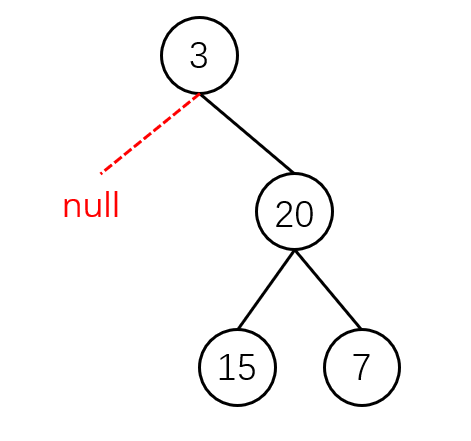
如图所示的情况并不能说最小深度为1.null并不能算作叶子节点,只有当左右孩子都为空的时候,才说明遍历的最低点了
如果左子树为空,右子树不为空,说明最小深度是 1 + 右子树的深度。
如果右子树为空,左子树不为空,最小深度是 1 + 左子树的深度。
最后如果左右子树都不为空,返回左右子树深度最小值 + 1 。
int leftDepth = minDepth(root.left);
int rightDepth = minDepth(root.right);
if (root.left == null) {
return rightDepth + 1;
}
if (root.right == null) {
return leftDepth + 1;
}
// 左右结点都不为null
return Math.min(leftDepth, rightDepth) + 1;
完整代码:
// 递归-----------------------------------------------------------
public int minDepth1(TreeNode root) {
if (root == null) {
return 0;
}
int leftDepth = minDepth1(root.left);
int rightDepth = minDepth1(root.right);
if (root.left == null) {
return rightDepth + 1;
}
if (root.right == null) {
return leftDepth + 1;
}
// 左右结点都不为null
return Math.min(leftDepth, rightDepth) + 1;
}
// 递归-----------------------------------------------------------
222. 完全二叉树的节点个数
给你一棵 完全二叉树 的根节点 root ,求出该树的节点个数。
完全二叉树的定义如下:在完全二叉树中,除了最底层节点可能没填满外,其余每层节点数都达到最大值,并且最下面一层的节点都集中在该层最左边的若干位置。若最底层为第 h 层,则该层包含 1~ 2h 个节点。
示例1:
输入:root = [1,2,3,4,5,6]
输出:6
示例2:
输入:root = []
输出:0
示例3:
输入:root = [1]
输出:1
普通二叉树递归思路
求普通二叉树的节点个数
public int countNodes1(TreeNode root) {
if (root == null) {
return 0;
}
int leftNum = countNodes1(root.left);
int rightNum = countNodes1(root.right);
return leftNum + rightNum + 1;
}
满二叉树递归思路
这道题可以利用完全二叉树的性质来做,在完全二叉树中,除了最底层节点可能没填满外,其余每层节点数都达到最大值,并且最下面一层的节点都集中在该层最左边的若干位置。若最底层为第 h 层,则该层包含 1~ 2^(h-1) 个节点。
难点
- 完全二叉树只有两种情况:
- 就是满二叉树
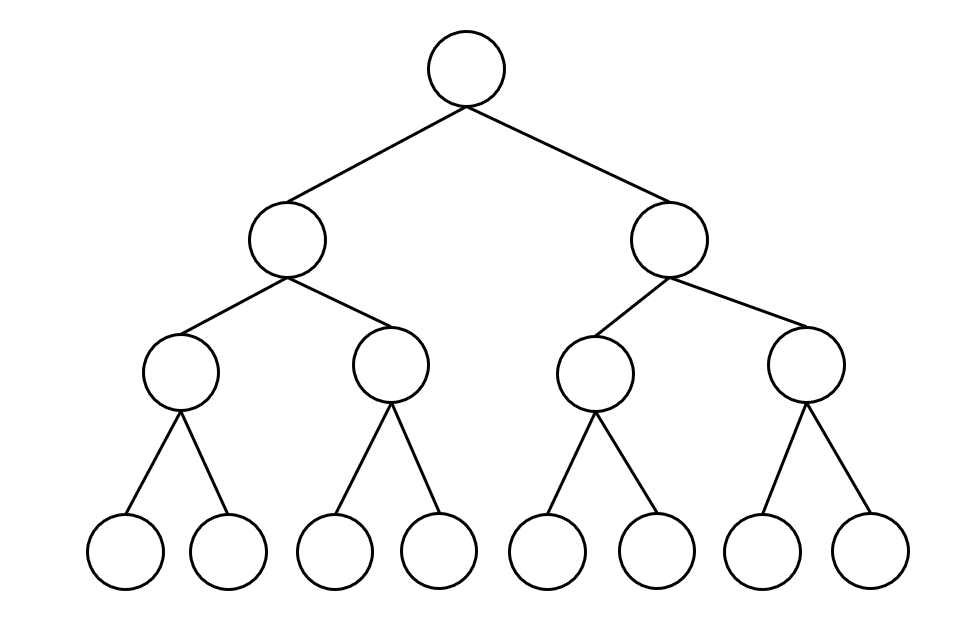
此时可以直接用 2^树深度 - 1 来计算,注意这里根节点深度为1。
- 不是满二叉树但可以找到二叉树:分别递归左孩子,和右孩子,递归到某一深度一定会有左孩子或者右孩子为满二叉树,然后依然可以按照情况1来计算。
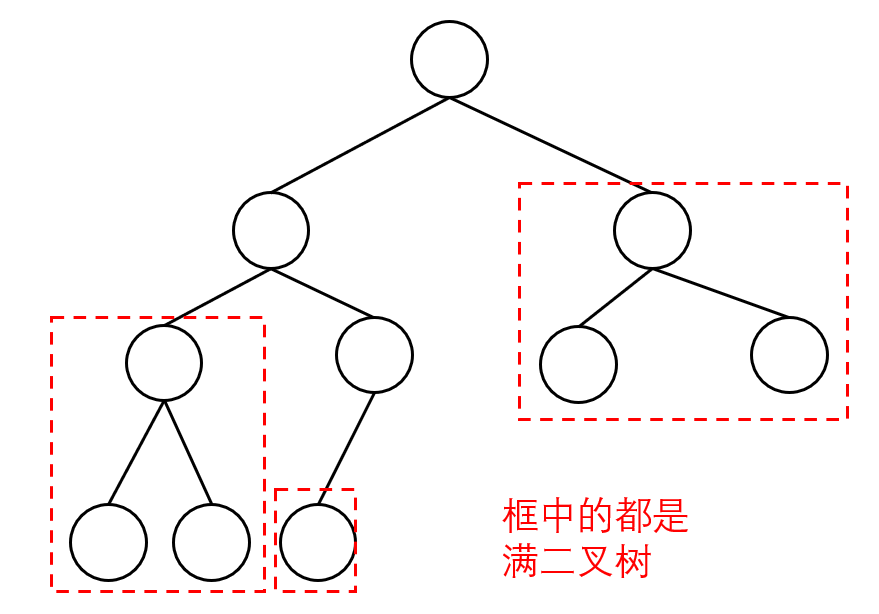
- 那么怎么判断一个左子树或者右子树是不是满二叉树呢?
在完全二叉树中,如果递归向左遍历的深度等于递归向右遍历的深度,那说明就是满二叉树
在完全二叉树中,如果递归向左遍历的深度不等于递归向右遍历的深度,则说明不是满二叉树
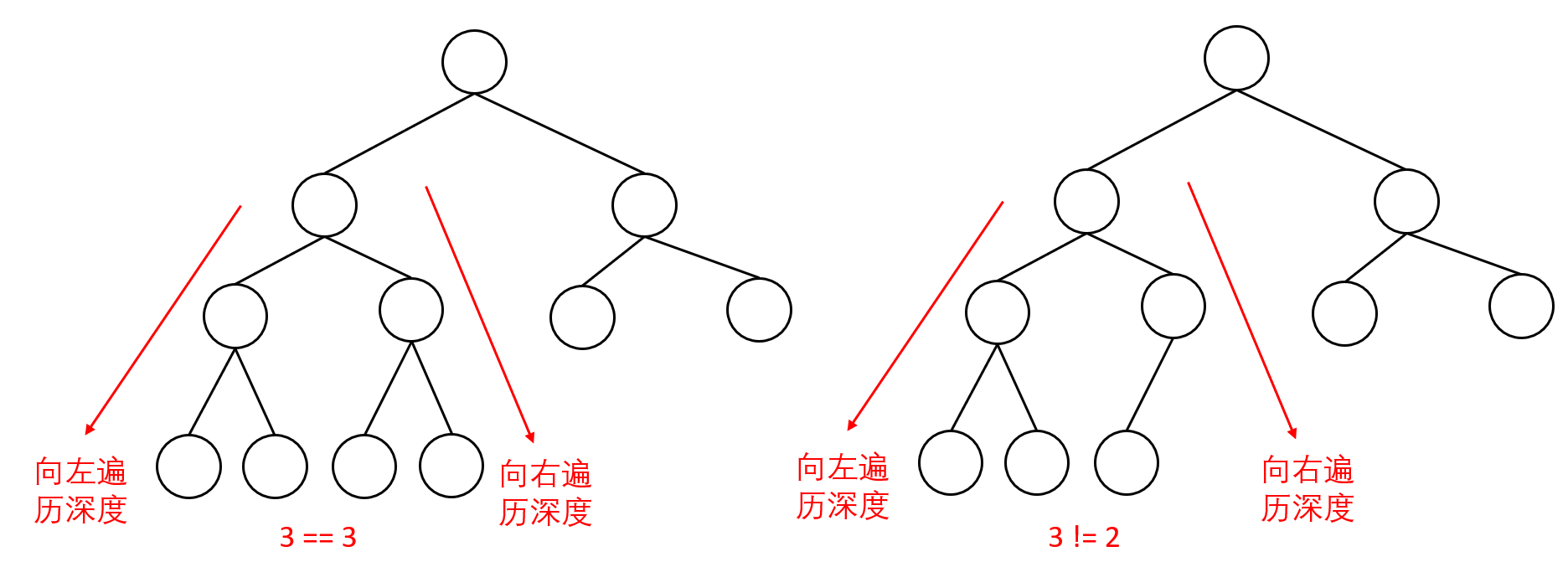
下面这种递归向左遍历的深度等于递归向右遍历的深度,但也不是满二叉树的情况不会存在。因为不是完全二叉树了。
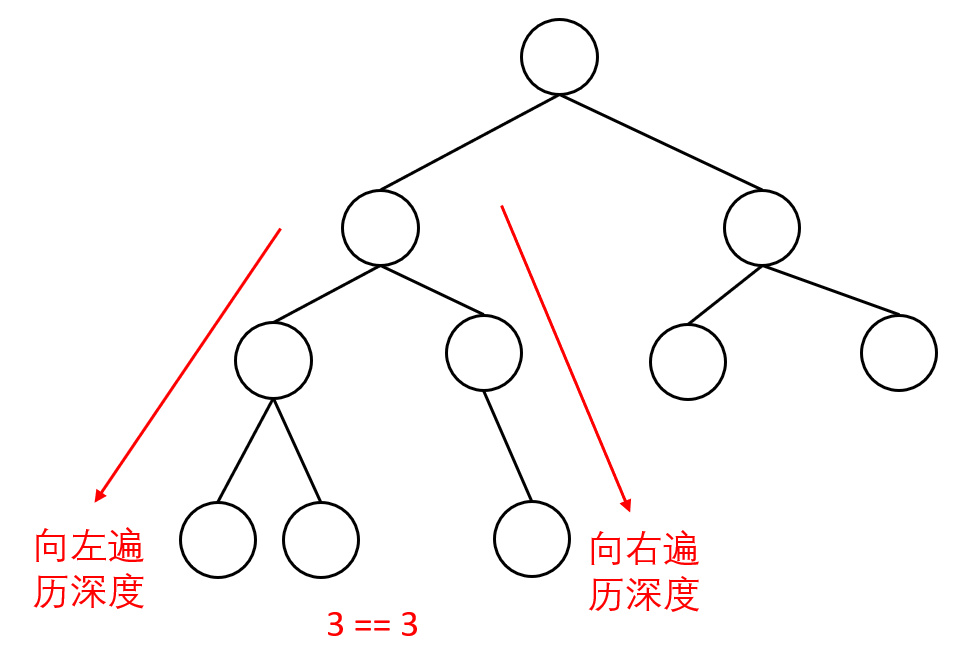
- 递归三要素
- 确定递归函数的参数和返回值:参数就是传入树的根节点,返回就返回以该节点为根节点二叉树的节点数量,所以返回值为int类型。
public int countNodes(TreeNode root)
- 确定终止条件:
if (root == null) {
return 0;
}
// 定义左右指针,计算左右侧深度
TreeNode left = root.left;
TreeNode right = root.right;
// 定义左右侧深度
int leftDepth = 0;
int rightDepth = 0;
// 求左子树深度
while (left != null) {
left = left.left;
leftDepth++;
}
// 求右子树深度
while (right != null) {
right = right.left;
rightDepth++;
}
if (leftDepth == rightDepth) {
return (2 << leftDepth) - 1; // 注意(2<<1) 相当于2^2,返回满足满二叉树的子树节点数量
}
要判断递归到的满二叉树是不是
- 确定单层递归的逻辑:先求它的左子树的节点数量,再求的右子树的节点数量,最后取总和再加一 (加1是因为算上当前中间节点)就是目前节点为根节点的节点数量。
int leftTreeNum = countNodes(root->left); // 左
int rightTreeNum = countNodes(root->right); // 右
int result = leftTreeNum + rightTreeNum + 1; // 中
return result;
完整代码:
public int countNodes(TreeNode root) {
if (root == null) {
return 0;
}
// 定义左右指针,计算左右侧深度
TreeNode left = root.left;
TreeNode right = root.right;
// 定义左右侧深度
int leftDepth = 0;
int rightDepth = 0;
// 求左子树深度
while (left != null) {
left = left.left;
leftDepth++;
}
// 求右子树深度
while (right != null) {
right = right.right;
rightDepth++;
}
if (leftDepth == rightDepth) {
return (2 << leftDepth) - 1; // 注意(2<<1) 相当于2^2,返回满足满二叉树的子树节点数量
}
int leftTreeNum = countNodes(root.left); // 左
int rightTreeNum = countNodes(root.right); // 右
int result = leftTreeNum + rightTreeNum + 1; // 中
return result;
}
迭代思路
就是层序遍历
完整代码:
public int countNodes(TreeNode root) {
if (root == null) return 0;
Queue<TreeNode> queue = new LinkedList<>();
queue.offer(root);
int result = 0;
while (!queue.isEmpty()) {
int size = queue.size();
while (size -- > 0) {
TreeNode cur = queue.poll();
result++;
if (cur.left != null) queue.offer(cur.left);
if (cur.right != null) queue.offer(cur.right);
}
}
return result;
}